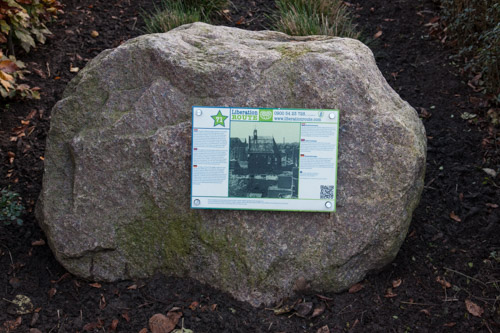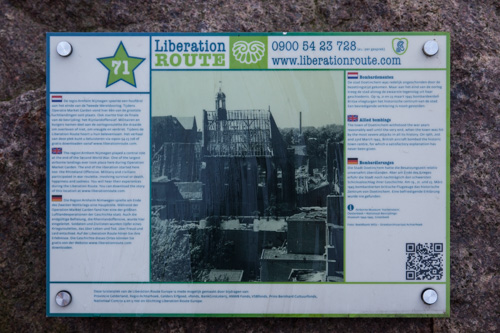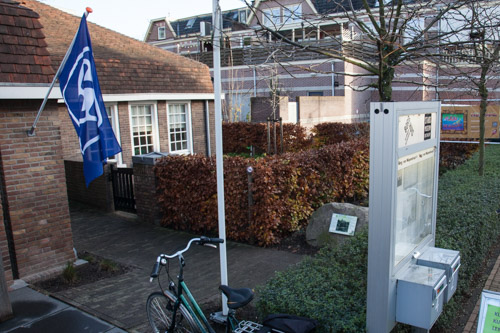Liberation Route Marker 071: Allied bombings
Allied bombings
The town of Doetinchem withstood the war years reasonably well until the very end, when the town was hit by the most severe attacks in all its history. On 19th, 21st and 23rd March 1945, British aircraft bombed the historic town centre, for which a satisfactory explanation has never been given.
At the end of the war, the allied air forces were continually bombing German towns, cities and strategic targets, in the hope that it would bring Germany to its knees more quickly. However, civilian targets in the Netherlands were often hit, which is what happened in Doetinchem on 19th, 21st and 23rd March 1945. The people of Doetinchem were taken completely by surprise. The historical town centre was damaged irreparably and the town hall, synagogue and St. Catherine’s Church went up in flames. In total, 120 buildings were destroyed, 143 people were killed and hundreds wounded.
Were the bombings intentional, or were they a mistake? No one really knows, yet the people of Doetinchem had their suspicions. The first attack (on 19th March) was meant to hit two strategic targets: a factory that made parts for aeroplanes and a communications station. These targets had been identified by the resistance, but the bombs missed both. The second attack (on 21st March) was apparently a mistake. The actual target was the German town of Isselborg, just over the border. Another explanation could have been an allied air force’s attempt to free the roads of German resistance from the air, considering the German occupiers had built substantial reinforcements in Doetinchem for sabotaging the allied advancement.
The German troops were quite happy with the situation and took advantage of the bombings. They used the ruins of the town to hide in and blocked off the entry roads with old tram carriages.
The resistance managed to save a few bridges before they were blown up and on 2nd April, after some heavy fighting, Doetinchem was liberated by the Canadian Army. The town centre was eventually rebuilt, but it had lost its heart and soul.
Audiospot - Allied bombings
Liberation Route Europe is a certified Cultural Route of the Council of Europe. With hundreds of sites and stories in nine European countries, the route links the main regions along the advance of the Allied Forces in 1943-1945.
The entire route consists of themed routes that can be travelled by by hiking, walking, cycling and car. These routes pass numerous historical and interesting sites and tell stories from a multitude of perspectives that were important in the final phase of World War II.
Many routes feature listening spots, offering the opportunity to listen to a historical story at a location. In addition, many ‘Vectors of Memory’ have been placed, indicating that the passer-by is on one of the Liberation Routes.
The routes can be found on the Liberation Route Europe website or in the app through which many stories can also be listened to.
Do you have more information about this location? Inform us!
Source
- Text: TracesOfWar & Liberation Route Europe
- Photos: Arjan Vrieze
Nearby
Museum
Point of interest
- Villa Bouchina - Doetinchem
- M4A4 Sherman Tank Doetinchem - Doetinchem
- Russian Hiding Place Doetinchem - Doetinchem
Monument
- St. Catherine's Church, Doetinchem - Doetinchem
- Jewish Memorial Doetinchem - Doetinchem
- Canadian Memorial Doetinchem - Doetinchem
Cemetery
- Commonwealth War Graves General Cemetery Doetinchem - Doetinchem
- Dutch War Graves General Cemetery Doetinchem - Doetinchem
- Dutch Reformed Cemetery Hummelo - Hummelo
Remembrance Stone
- Stumbling Stones Grotestraat 22 - Wehl
- Stumbling Stones Dorpsstraat 14 - Laag-Keppel
- Stumbling Stones Jonkheer de Bellefroidweg 1 - Wehl
Fortification
- Kochbunker 'Kale Jacob 1' Montferland - Kilder
- Kochbunker 'Kale Jacob 2' Montferland - Zeddam
- Kochbunker 'Kale Jacob 3' Montferland - Zeddam






